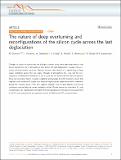Files in this item
The nature of deep overturning and reconfigurations of the silicon cycle across the last deglaciation
Item metadata
| dc.contributor.author | Dumont, Matthew Declan | |
| dc.contributor.author | Pichevin, L. | |
| dc.contributor.author | Geibert, W. | |
| dc.contributor.author | Crosta, X. | |
| dc.contributor.author | Michel, E. | |
| dc.contributor.author | Moreton, S. | |
| dc.contributor.author | Ganeshram, R. | |
| dc.date.accessioned | 2020-03-25T11:30:01Z | |
| dc.date.available | 2020-03-25T11:30:01Z | |
| dc.date.issued | 2020-03-24 | |
| dc.identifier | 266187007 | |
| dc.identifier | be5e20ab-b7d5-47fb-a492-74089a35977f | |
| dc.identifier | 85082380118 | |
| dc.identifier | 000530024600004 | |
| dc.identifier.citation | Dumont , M D , Pichevin , L , Geibert , W , Crosta , X , Michel , E , Moreton , S & Ganeshram , R 2020 , ' The nature of deep overturning and reconfigurations of the silicon cycle across the last deglaciation ' , Nature Communications , vol. 11 , 1534 . https://doi.org/10.1038/s41467-020-15101-6 | en |
| dc.identifier.issn | 2041-1723 | |
| dc.identifier.uri | https://hdl.handle.net/10023/19704 | |
| dc.description | Funding: NERC E3 DTP studentship awarded to M. Dumont and NERC Grant (NE/J02371X/1) award to R.S. Ganeshram and L.E. Pichevin. | en |
| dc.description.abstract | Changes in ocean circulation and the biological carbon pump have been implicated as the drivers behind the rise in atmospheric CO2 across the last deglaciation; however, the processes involved remain uncertain. Previous records have hinted at a partitioning of deep ocean ventilation across the two major intervals of atmospheric CO2 rise, but the consequences of differential ventilation on the Si cycle has not been explored. Here we present three new records of silicon isotopes in diatoms and sponges from the Southern Ocean that together show increased Si supply from deep mixing during the deglaciation with a maximum during the Younger Dryas (YD). We suggest Antarctic sea ice and Atlantic overturning conditions favoured abyssal ocean ventilation at the YD and marked an interval of Si cycle reorganisation. By regulating the strength of the biological pump, the glacial–interglacial shift in the Si cycle may present an important control on Pleistocene CO2 concentrations. | |
| dc.format.extent | 11 | |
| dc.format.extent | 2522945 | |
| dc.language.iso | eng | |
| dc.relation.ispartof | Nature Communications | en |
| dc.subject | GE Environmental Sciences | en |
| dc.subject | DAS | en |
| dc.subject.lcc | GE | en |
| dc.title | The nature of deep overturning and reconfigurations of the silicon cycle across the last deglaciation | en |
| dc.type | Journal article | en |
| dc.contributor.institution | University of St Andrews. School of Earth & Environmental Sciences | en |
| dc.identifier.doi | 10.1038/s41467-020-15101-6 | |
| dc.description.status | Peer reviewed | en |
| dc.date.embargoedUntil | 2020-03-24 |
This item appears in the following Collection(s)
Items in the St Andrews Research Repository are protected by copyright, with all rights reserved, unless otherwise indicated.

